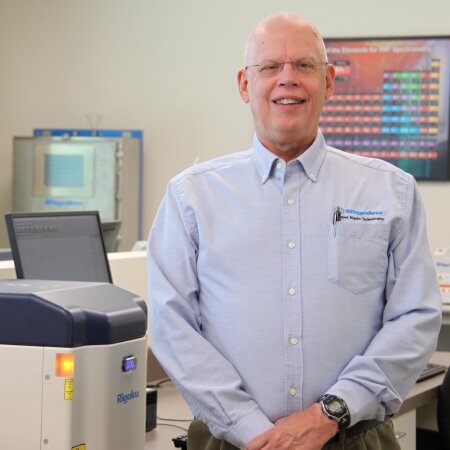Application Note EDXRF1856

Scope
Measurement of additive elements phosphorus (P), sulfur (S), chlorine (Cl), calcium (Ca), zinc (Zn) and molybdenum (Mo) in lubricating oils by ASTM D7751 is demonstrated.
Background
Controlling additive elements when blending new, fresh lubricating oils is vital to ensure correct lubrication properties and minimizing production waste and product rejection. EDXRF is a fast and simple analytical technique for use by non-technical operators, yet powerful enough for expert use in the research & development of new lube oil formulations. To meet the industry needs in production and research, Rigaku NEX DE offers compliance to D7751 Standard Test Method for Additive Elements in Lubricating Oils by EDXRF Analysis for P, S, Cl, Ca, Zn, and Mo.
Table 1: Elements and range ofapplicability
| ASTM D7751-16 | ||
| Element | PLOQ in mass% | Max Concentration in mass% |
| Magnesium* | 0.018 | 0.10 |
| Phosphorous | 0.024 | 0.125 |
| Sulfur | 0.008 | 1.94 |
| Chlorine | 0.0007 | 0.05 |
| Calcium | 0.002 | 0.44 |
| Zinc | 0.040 | 0.143 |
| Molybdenum | 0.004 | 0.047 |
* Rigaku Indirect Excitation model NEX CG complies with ASTM D7751 for the measurement of Mg
Calibration
Empirical calibrations were built using a suite of 22 commercially available calibration standards, fewer standards may be used with a minimum of 12 standards. The suite of calibration standards must be representative of the lube oil formulation to be analyzed. Elements in the lube oil should vary evenly over each concentration range of interest, and the elements in the oil vary independently of each other. Empirical alpha corrections are then employed to automatically compensate for variations in X-ray absorption and enhancement effects within the sample due to the independent variations in element concentration. A summary of the empirical calibrations is shown here.
| Element | Concentration range mass% |
| P | 0.010 – 0.250 |
| S | 0.050 – 1.500 |
| Cl | 0.0025 – 0.401 |
| Ca | 0.025 – 1.000 |
| Zn | 0.010 – 0.250 |
| Mo | 0.010 – 0.250 |
Precision
Two representative samples from the calibration suite were chosen to demonstrate typical instrument repeatability (precision). Ten repeat analyses of the sample were performed with the sample in static position.
| Sample: 13 Units: mass% |
||||
| Element | Standard value | Average value | Std. dev | % Relative |
| P | 0.140 | 0.1476 | 0.0005 | 0.3 |
| S | 1.109 | 1.109 | 0.0007 | 0.1 |
| Cl | 0.4007 | 0.4001 | 0.0026 | 0.7 |
| Ca | 0.051 | 0.0548 | 0.00017 | 0.3 |
| Zn | 0.1100 | 0.1138 | 0.0002 | 0.2 |
| Mo | 0.0281 | 0.0294 | 0.00013 | 0.5 |
| Sample: 13 Units: mass% |
||||
| Element | Standard value | Average value | Std. dev | % Relative |
| P | 0.150 | 0.1513 | 0.0004 | 0.3 |
| S | 0.350 | 0.3460 | 0.0006 | 0.3 |
| Cl | 0.0250 | 0.0261 | 0.0002 | 1.1 |
| Ca | 0.950 | 0.9457 | 0.0016 | 0.2 |
| Zn | 0.0601 | 0.0595 | 0.00008 | 0.1 |
| Mo | 0.0260 | 0.0252 | 0.00012 | 0.5 |
Conclusion
The Rigaku NEX DE combines a unique set of tube filters with high-throughput SDD to give excellent low background and high-count-rate collection.
Empirical calibration is used to determine ASTM D7751 compliance. Rigaku RPF-SQX fundamental parameters can also be used in association with user-definable Matching Libraries to encompass families of lubricants in a single method and for use with R&D testing new formulations, making NEX DE an excellent tool for process and quality control in the manufacturing of lube oil formulations and blends as well as R&D and other uses.

